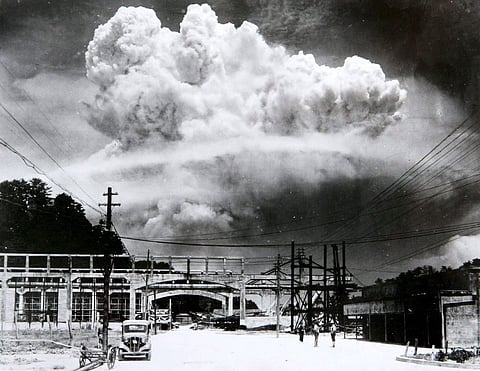
- Home
- NG Hindi
- India
- World
- Politics
- Sex & Relationships
- Entertainment
- Culture
- Lifestyle
- Economy
- Sports
- Sp. Coverage
- Misc.
- NewsGram Exclusive
- Jobs / Internships

By Nithin Sridhar
On the early morning of August 6th, 1945, Colonel Paul W. Tibbets Jr. of United States Air Force and his crew flew Enola Gay, the Boeing B29 Bomber, into the city of Hiroshima and dropped "Little Boy" precisely at 8:15 am.
"Little Boy" was none other than the very first atomic bomb that contained 64 kg of uranium-235.
After 44 seconds, the bomb exploded directly above Shima Surgical Clinic in Hiroshima. The Little Boy caused a blast that was equivalent to a blast by 16 kilotons of TNT. There was a total destruction within 1 km radius and a future destruction due to firestorm happened within 4-5 km radius.
The Hiroshima bombing by the Little Boy was followed by Nagasaki bombing by "Fat Man" on August 9th, 1945. On the one hand, the bombings forced the Japanese to surrender and ended the Second World War. On the other hand, it resulted in thousands of people in these two cities suffering for many generations.
Today is the 70th anniversary of this great tragedy that resulted in an end to a War which could have led to a greater tragedy if it had not been stopped.
Why America chose to use Atomic Bombs
There has been a lot of criticism in the aftermath of the Second World War regarding the decision of Harry S. Truman, the then President of US to drop atomic bombs on Japan. But, at the same time, it has been well established that during the war itself, the President received advice from various military and civil personnel including many scientists regarding the use of atomic bomb.
The US explored various options like continued naval blockade, air bombardment and eventual invasion of Japan in order to end the war as the Japanese were not ready for unconditional surrender.
In his thesis "America's Decision to Drop the Atomic Bomb on Japan", Joseph H. Paulin says:
"During the time President Truman authorized the use of the atomic bomb against Japan, the United States was preparing to invade the Japanese homeland. The brutality and the suicidal defenses of the Japanese military had shown American planners that there was plenty of fight left in a supposedly defeated enemy. Senior military and civilian leaders presented Truman with several options to force the surrender of Japan. The options included the tightening of the naval blockade and aerial bombardment of Japan, invasion, a negotiated peace settlement, and the atomic bomb became an option, once bomb became operational.
"Truman received recommendations, advice, and proposals from civilian and military leaders within the first two months of taking office after President Roosevelt died. Only after meeting with the senior leadership to discuss the various options did Truman authorize the planning and execution of the invasion of Japan. However, the extremely large casualty estimates presentedby the Chiefs of Staff remained a concern for Truman, especially in the wake of the bloody battles on Iwo Jima and Okinawa.These estimates became the driving factor for Truman's ultimate decision to use the new weapon against Japan and to end the war before any more Americans service members died unnecessarily."
In 1945, Quincy Wright and William Shockley prepared a report assessing the probable causalities in the event of an American invasion of Japan. The report estimated that an American invasion of Japan would lead to deaths of 5-10 million Japanese and 1-4 million casualties on the American side including the deaths of 400,000 to 800,000 American soldiers.
Therefore, the driving force behind American decision to drop atomic bombs were to end the war as soon as possible and to prevent further loss of Americans who are fighting the war. Other factors that might have influenced the decision to use the bombs include using it as a justification for spending huge cost on Manhattan project (around $1,889,604,000, 1945 dollar rate) that produced the bomb, and as a response to the Japanese attack on Pearl Harbor.
The casualties of Hiroshima and Nagasaki bombing
Whatever may have been the reason, the bombing of Hiroshima and Nagasaki forced the Japanese to surrender, but at a great cost to human lives.
In Hiroshima, around 70,000-80,000 people died immediately and another 70,000 people were injured due to the blast and the resultant firestorm. The total figures of those who died reached about 140,000 by December 1945. Around 92% of the 76000 buildings were destroyed or damaged beyond repairs by the blast. In Nagasaki, at least 39,000 people died and another 25,000 people were injured.
The radiation from the bomb explosion had long-term health effects on the Japanese survivors of the war including causing leukemia, blood disorder, solid cancer and keloids. A study by Radiation Effects Research Foundation shows that between 1950 and 2000, 46% of leukemia deaths and 11% of solid cancer deaths among the bomb survivors were due to their exposure to radiation from the bombs.
These heavy causalities and the long-term effects of the atomic bombs must serve as a lesson for the people in power to make sure that a situation wherein the use of these bombs become inevitable, like Second World War, never again arise.
